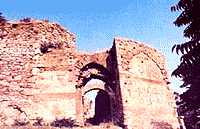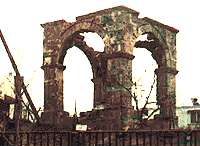Didimoticho, today a small town of approximately 12000 people, bears a long and extremely noteworthly history. The city is lying next to the Erythropotamos river, on the western bank of the famous Hevros river.
The first habitation was founded on the Hagia Petra hill at the Southestern end of the city in the neilithic period, according recent excavational evidence. During the Early Iron Age two villages existed together in both hills of the city, Hagia Petra and Kales, the second lying at the western end of today's Didymotichon.
 Abundant quantities of ceramics as well as other findings from the anciend historic times witness not only the existence of a city at that period but, even more, its close relations with the Greeks.
Abundant quantities of ceramics as well as other findings from the anciend historic times witness not only the existence of a city at that period but, even more, its close relations with the Greeks.
During the "Pax Romana" the emperor Traianos re-established the city, donouring it with the name of his wife, Plotina. Plotinopolis became one of the most importan cities of Roman Trace, being itself under an autonomus regime. The city reached a remarkable status of welfare, reflected on random findings or results of the few excavational works done up to now: floor mosaics represending the Hercules deeds and the Zeus - Swan and and Leda legend, or the famous golden head of the emperor Septimius Severus.
The decadence of the Empire & the barbaric invasions & lootings caused the gradual transportation of the city from the hill Hagia Petra to that of the Kales. It's perhaps then that the Didimoticho took it's last name, if we accept, if we accept that it meens Twin (=Dodimo) castles.
 During the Byzantine period the importance of the city is growing, because of its crusial geostrategic position and its steep, impregnable strondhold of Kales were it lied. This costantly growing significance it well marked by writers of the Middle and late Byzantine times, greeks as well as foreigners, like Godfried Villeharduin, who stresses that "Didimoticho was the strongest and one of the richest cities of Romania (=the territory of the Byzantine empire). Especially during the Paleologan period (13th and 1st half of the 14th century) Didimoticho becomes the focus of the historical events: capital of the emperors Andoronicos III the Paleologos and Ioannis the sixth Katakuzenos during the catastrophic civil wars of 1321 to 1354, also witnesses the birth of "Purple- born" emperors as well as royal weddings, imperial visitors or prisoners, foreign ampassadors, assembassadors, assemblage of the imperial army, inauguration of two emperors, etc. Unfortunately only recently excavations have began to bear in light the expected traces of this glorious past.
During the Byzantine period the importance of the city is growing, because of its crusial geostrategic position and its steep, impregnable strondhold of Kales were it lied. This costantly growing significance it well marked by writers of the Middle and late Byzantine times, greeks as well as foreigners, like Godfried Villeharduin, who stresses that "Didimoticho was the strongest and one of the richest cities of Romania (=the territory of the Byzantine empire). Especially during the Paleologan period (13th and 1st half of the 14th century) Didimoticho becomes the focus of the historical events: capital of the emperors Andoronicos III the Paleologos and Ioannis the sixth Katakuzenos during the catastrophic civil wars of 1321 to 1354, also witnesses the birth of "Purple- born" emperors as well as royal weddings, imperial visitors or prisoners, foreign ampassadors, assembassadors, assemblage of the imperial army, inauguration of two emperors, etc. Unfortunately only recently excavations have began to bear in light the expected traces of this glorious past.
An imperial foundation next to Agios Athanassios post/byzantine church where the excavation has revealed a peculiar structure and some unique fragments of byzantine frescoes the humple funeral chapel of Hagia Aikaterini the hundreds of rock/cut caves, shaped by the medieval inhabitants of the city as cisterns or storerooms at the back of their houses and of course the byzantine walls retaining building phases from Justinian time to the early Ottoman period on tje surfaces of towels and in the castle one still can see monograms of byzantine nobles, imperial families etc.
 Festivals:
Festivals:
Each year on the last Monday before Halloween, in February, a revival of the satirical custom of "Kiopek-Bey" takes place in Didimoticho.
In May the city celebrates the liberation of the city from the Turks in May 1920 with various cultural events which last for ten days.
Each August the celebration of the byzantine castle takes place followed by the two weeked international meeting of young artists from the Balkans and Russia.
In the middle a large commercial market is organised in the city.
The first habitation was founded on the Hagia Petra hill at the Southestern end of the city in the neilithic period, according recent excavational evidence. During the Early Iron Age two villages existed together in both hills of the city, Hagia Petra and Kales, the second lying at the western end of today's Didymotichon.
 Abundant quantities of ceramics as well as other findings from the anciend historic times witness not only the existence of a city at that period but, even more, its close relations with the Greeks.
Abundant quantities of ceramics as well as other findings from the anciend historic times witness not only the existence of a city at that period but, even more, its close relations with the Greeks.During the "Pax Romana" the emperor Traianos re-established the city, donouring it with the name of his wife, Plotina. Plotinopolis became one of the most importan cities of Roman Trace, being itself under an autonomus regime. The city reached a remarkable status of welfare, reflected on random findings or results of the few excavational works done up to now: floor mosaics represending the Hercules deeds and the Zeus - Swan and and Leda legend, or the famous golden head of the emperor Septimius Severus.
The decadence of the Empire & the barbaric invasions & lootings caused the gradual transportation of the city from the hill Hagia Petra to that of the Kales. It's perhaps then that the Didimoticho took it's last name, if we accept, if we accept that it meens Twin (=Dodimo) castles.
 During the Byzantine period the importance of the city is growing, because of its crusial geostrategic position and its steep, impregnable strondhold of Kales were it lied. This costantly growing significance it well marked by writers of the Middle and late Byzantine times, greeks as well as foreigners, like Godfried Villeharduin, who stresses that "Didimoticho was the strongest and one of the richest cities of Romania (=the territory of the Byzantine empire). Especially during the Paleologan period (13th and 1st half of the 14th century) Didimoticho becomes the focus of the historical events: capital of the emperors Andoronicos III the Paleologos and Ioannis the sixth Katakuzenos during the catastrophic civil wars of 1321 to 1354, also witnesses the birth of "Purple- born" emperors as well as royal weddings, imperial visitors or prisoners, foreign ampassadors, assembassadors, assemblage of the imperial army, inauguration of two emperors, etc. Unfortunately only recently excavations have began to bear in light the expected traces of this glorious past.
During the Byzantine period the importance of the city is growing, because of its crusial geostrategic position and its steep, impregnable strondhold of Kales were it lied. This costantly growing significance it well marked by writers of the Middle and late Byzantine times, greeks as well as foreigners, like Godfried Villeharduin, who stresses that "Didimoticho was the strongest and one of the richest cities of Romania (=the territory of the Byzantine empire). Especially during the Paleologan period (13th and 1st half of the 14th century) Didimoticho becomes the focus of the historical events: capital of the emperors Andoronicos III the Paleologos and Ioannis the sixth Katakuzenos during the catastrophic civil wars of 1321 to 1354, also witnesses the birth of "Purple- born" emperors as well as royal weddings, imperial visitors or prisoners, foreign ampassadors, assembassadors, assemblage of the imperial army, inauguration of two emperors, etc. Unfortunately only recently excavations have began to bear in light the expected traces of this glorious past. An imperial foundation next to Agios Athanassios post/byzantine church where the excavation has revealed a peculiar structure and some unique fragments of byzantine frescoes the humple funeral chapel of Hagia Aikaterini the hundreds of rock/cut caves, shaped by the medieval inhabitants of the city as cisterns or storerooms at the back of their houses and of course the byzantine walls retaining building phases from Justinian time to the early Ottoman period on tje surfaces of towels and in the castle one still can see monograms of byzantine nobles, imperial families etc.
 Festivals:
Festivals:Each year on the last Monday before Halloween, in February, a revival of the satirical custom of "Kiopek-Bey" takes place in Didimoticho.
In May the city celebrates the liberation of the city from the Turks in May 1920 with various cultural events which last for ten days.
Each August the celebration of the byzantine castle takes place followed by the two weeked international meeting of young artists from the Balkans and Russia.
In the middle a large commercial market is organised in the city.

